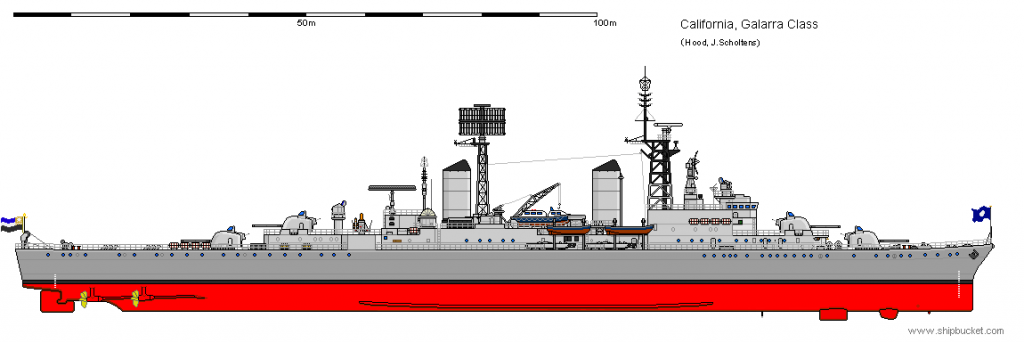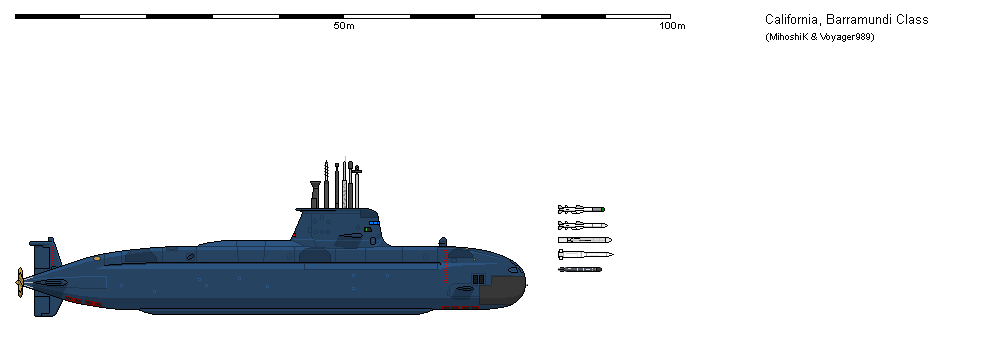Page 7 of 24
Re: The Isle of California
Posted: September 27th, 2013, 8:08 pm
by erik_t
Long Beach's phased array sets were for very long range search and track, and were sufficiently long-wavelength to see through some of the after clutter. You're using S-band, and you're using it for tracking and intercept control. To be blunt, this will work badly if at all.
There's a good reason CGN-42 and the CSGNs looked very little like Long Beach, and indeed why the notional Long Beach Aegis refit looked so dramatically different.
Re: The Isle of California
Posted: September 27th, 2013, 11:37 pm
by Voyager989
While there is little information on SCANFAR I have been able to find, AN/SPS-32 was said to be S-Band in a table of electronically scanned radars in a book on Gallium Arsenide chips, and AN/SPS-33 is said to be S-Band in multiple places - given this was the "target-indication" half of the set, I see no reason to doubt this, though I am more skeptical about the longer-ranged half. Something more like P-band seems more likely.
As a descendant of a radar designed to perform as Type 985 and SCANFAR did, but with the benefit of more than twenty years of research and development, it seems likely to work, even if the configuration of the arrays was fixed too early in the design process to do something like AEGIS. S-Band seems to have worked perfectly well on the Type 984 for search and track as well, if not as long ranged as SPS-32. More modern computers should improve its' ability to filter out clutter and noise and resist jamming, no?
Re: The Isle of California
Posted: September 28th, 2013, 5:13 am
by Voyager989

I did produce an alternate version with the array moved aft, but worried about topweight - if the blind spot is so important, than the ship can be made beamier to "make it work" at a cost in speed.
Re: The Isle of California
Posted: September 30th, 2013, 3:50 pm
by erik_t
SPS-32 was unequivocally a P-band radar. SPS-33 was in fact S-band. I would be hesitant to base anything on the SPS-33 installation, since it never worked worth a damn (which is nobody's real fault, the thing was borderline-experimental). In any case, more advanced computers and whatnot are not going to help you see through solid blockage, which is your current situation. In any case I do not know why you think you need such massive S-band arrays in this era; you're not exactly performing boost-phase ABM or anything.
Re: The Isle of California
Posted: September 30th, 2013, 4:57 pm
by TimothyC
One thing that might effect the array size is that the Californians and the US often have problems getting along, ad as such the US puts export restrictions on some computer technology exports - which actually effects a surprising large amount of modern western european kit.
Re: The Isle of California
Posted: November 5th, 2013, 12:14 am
by Voyager989

The Galarra class - conceptualized in the wake of the Second World War and built as a modern escort for carrier groups, to serve as air-direction vessels or pickets as required, a series of sixteen were built, replacing the worn pre-war small cruiser force as leaders for the large fleet destroyer flotillas. They proved unwieldy in the ASW role, and had to serve in second-line roles all the way into the start of the major fleet modernizations of the 1980's.

Seventeen of these vessels were built - something the Navy is still believed to regret. Only two were completed in their original SSRN role - their large size and commodious internal space once the second reactor plant was removed saw a second role - carrying spare nuclear weapons and crews for the Navy's seaplane heavy bomber force to re-arm for a second strike, and refuel via pre-positioned submerged fuel tanks in various deserted atolls throughout the Pacific. They left service with the end of the Cold War, by which time they were regarded as being approximately as survivable against the Soviet and American SSN forces during transit as a donut in an American police station. The last five completed as the Navy's first SSBNs, carrying their missiles in the former forward reactor and engine compartments.

The far more 'rational' use of nuclear power for submarines, these were the first hunter-killer/commerce attack submarines built using the new technology. Quieter than Soviet boats, and competitive with early American craft, they did not begin to leave service until the 80's, as further upgrades to their deteriorating propulsion systems were deemed to be a waste of ship repair funding.

With the growing threat posed by Soviet and American strategic forces, the second-generation submarine program was hurriedly re-oriented to produce a more survivable SSBN - even being refitted, the Gawuras would never be optimal in their ability to hide - a total of seven were built to provide four on patrol at any given time.

The attack submarine counterpart to the Vigilant-class, named for the cruiser that was ingloriously piled onto a reef during a typhoon in 1963. These boats were worked gently starting in the 1990's onwards, as submarine priorities rapidly entered a period of massive flux.

With the first units laid down in the mid 1980's, the first tranche of seven boats replaced the Gawura SSBNs - the second tranche replaced the land-based ICBM force in the face of the inability to sufficiently harden the two wings in the face of a first strike. (Echoing the debates over MX in the United States.) This decision, taken late in 1990, threw havoc into the submarine building program, delaying the next SSN, and seeing the planned SSK brought forward and increased to twelve boats.

Stationed in four three-boat stations throughout the Empire, these boats, built from the late 1980's onwards, provide defence of choke points leading into Californian home waters - Tierra del Fuego, Larrakia (OTL Darwin), Persian Gulf, Red Sea.

Heirs to a storied lineage, these large, expensive SSNs did not enter production until the Rays of Dawn were completed - intended for a 1991 order, this slipped to 1999 - they are now replacing the Galarras, of which a dozen remain in service. A total of thirty vessels to this basic design are intended to be built, though wide differences between the currently planned three main batches is expected.
Re: The Isle of California
Posted: November 5th, 2013, 1:30 am
by Trojan
Wow! fantastic job!
Re: The Isle of California
Posted: November 5th, 2013, 8:42 am
by Rhade
Nice subs, I like that Gawura monster.
Re: The Isle of California
Posted: November 5th, 2013, 1:34 pm
by Hood
Nice additions. The Galarra destroyer looks a real monster. I really like the way you've mixed up the various Super Daring concepts into something looking quite powerful and mean, an all-gun County in effect. The hull looks a little skinny though.
The Marumara likewise, looks a little over-stretched and thin for a viable submarine design.
Re: The Isle of California
Posted: November 5th, 2013, 1:46 pm
by Shipright
Is the Charlotte Corday class a hybrid SSBN/SSN given the weapons load out? If so that is going to be one expensive boat!








